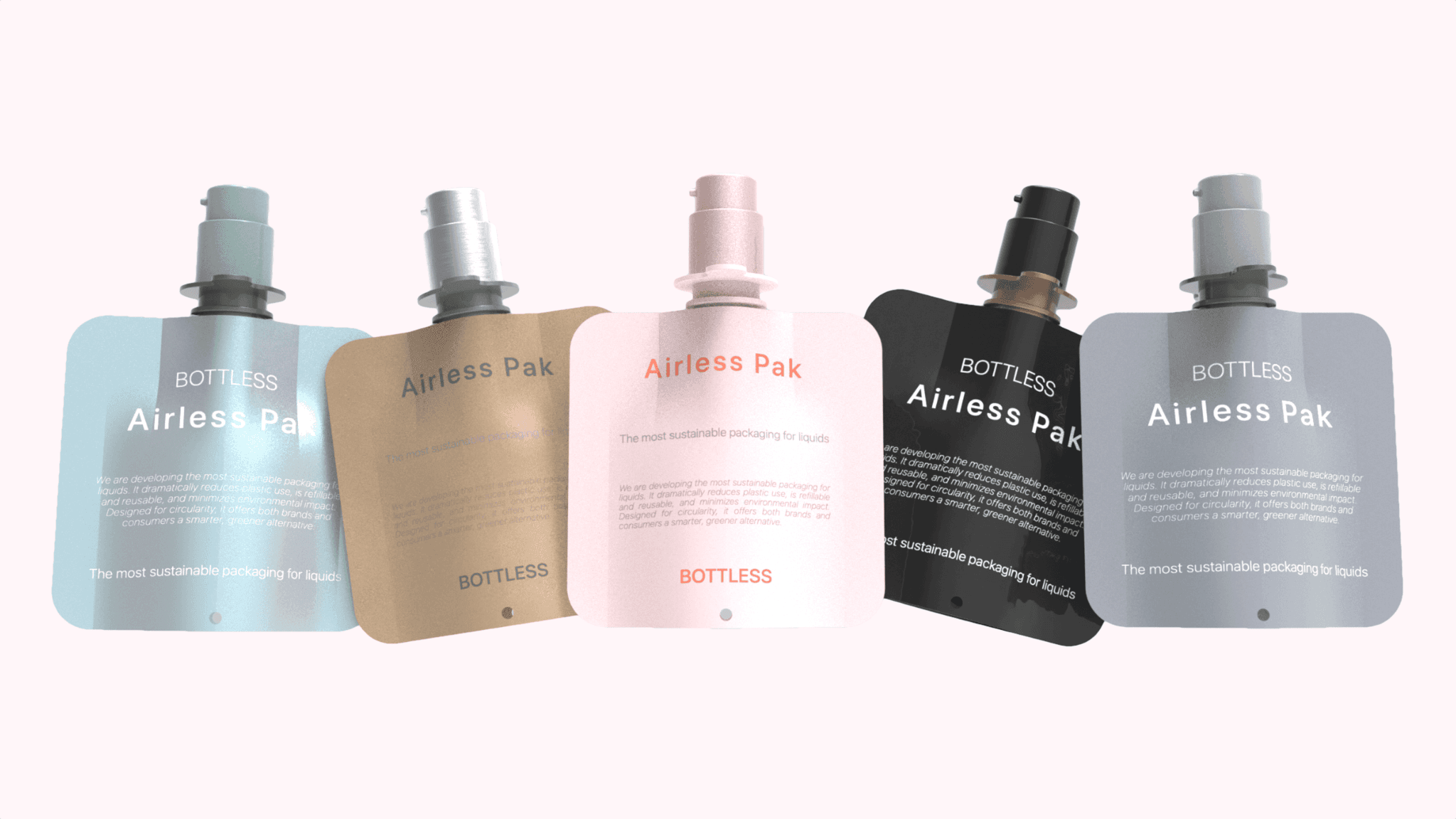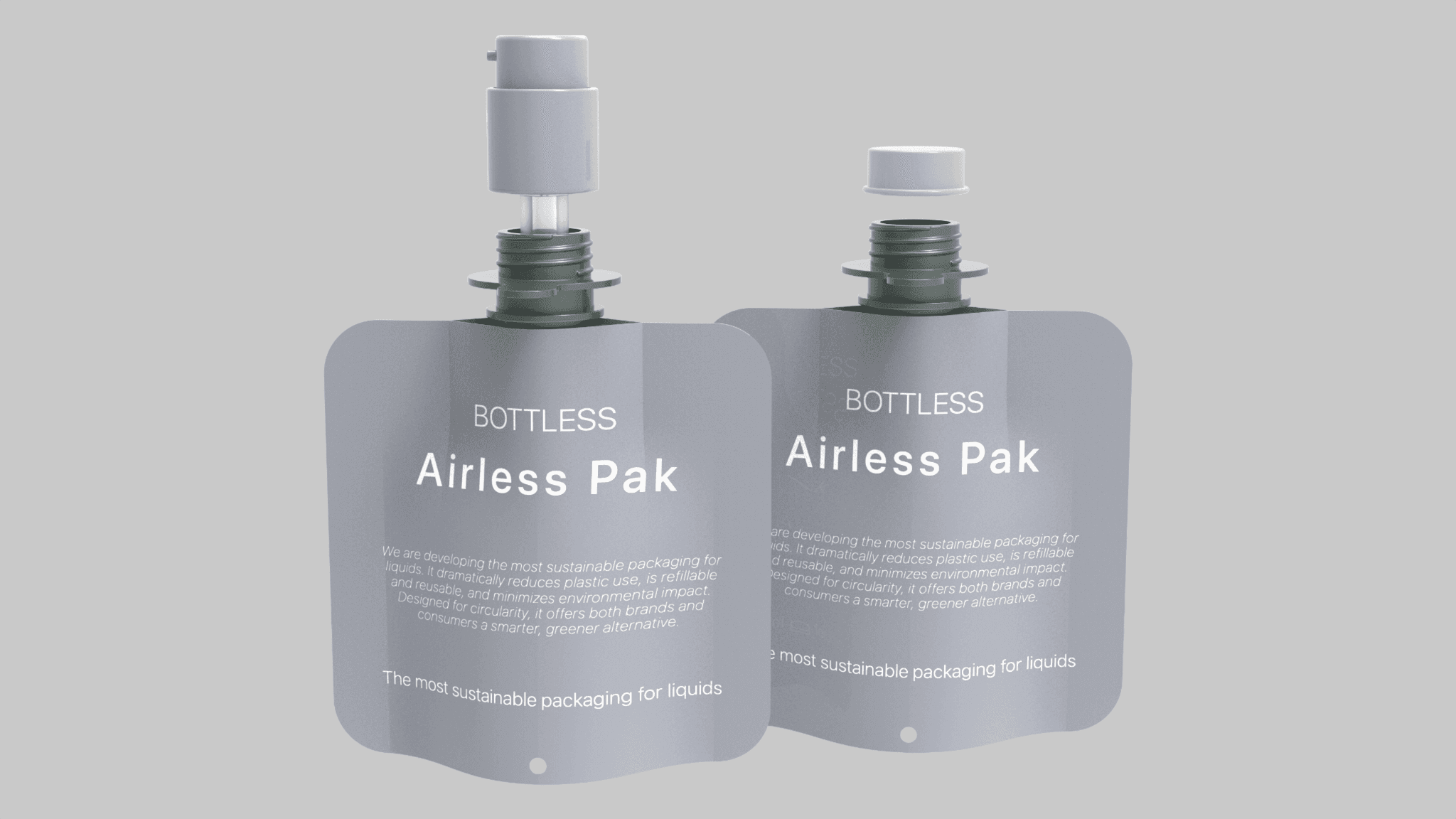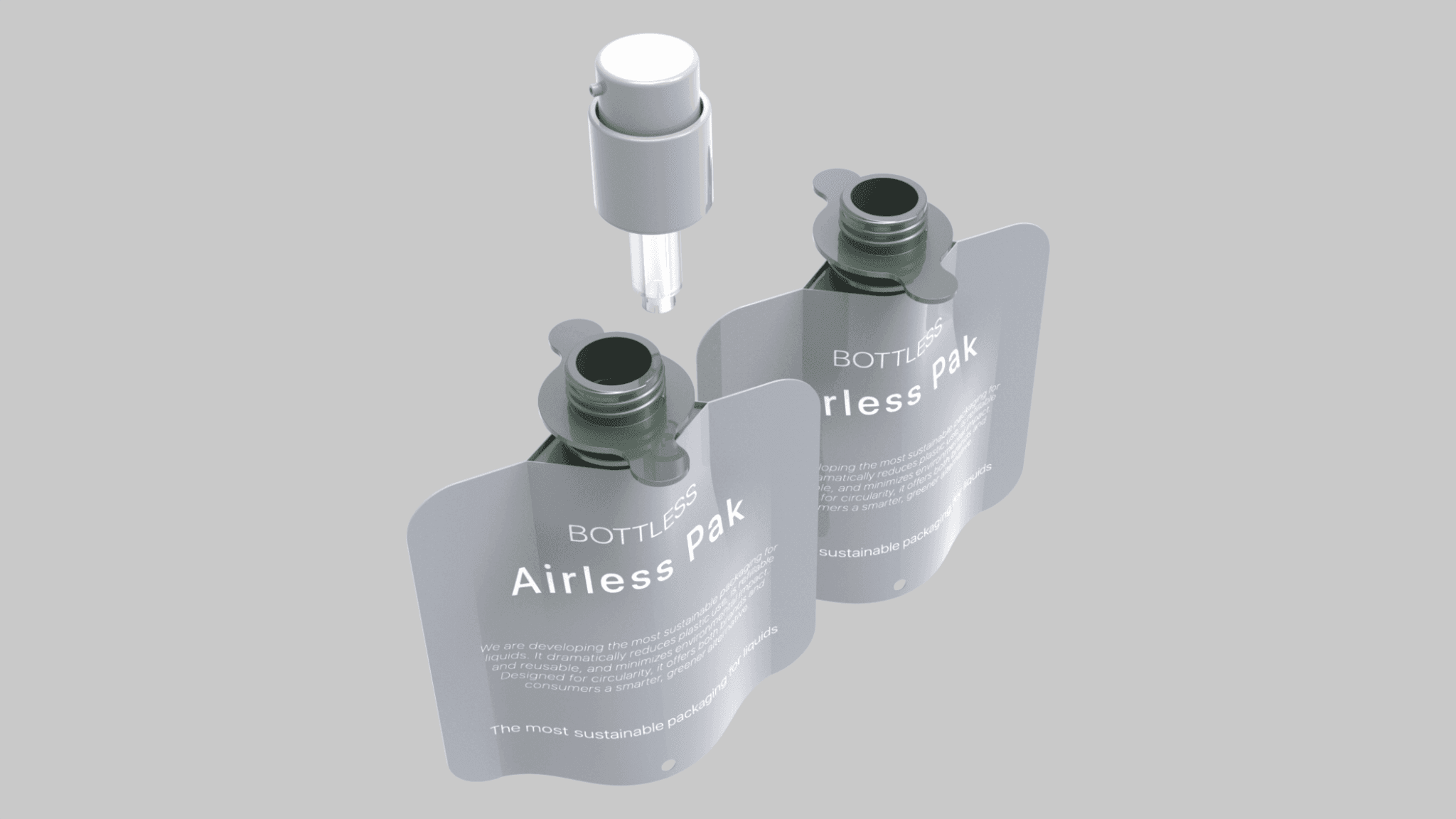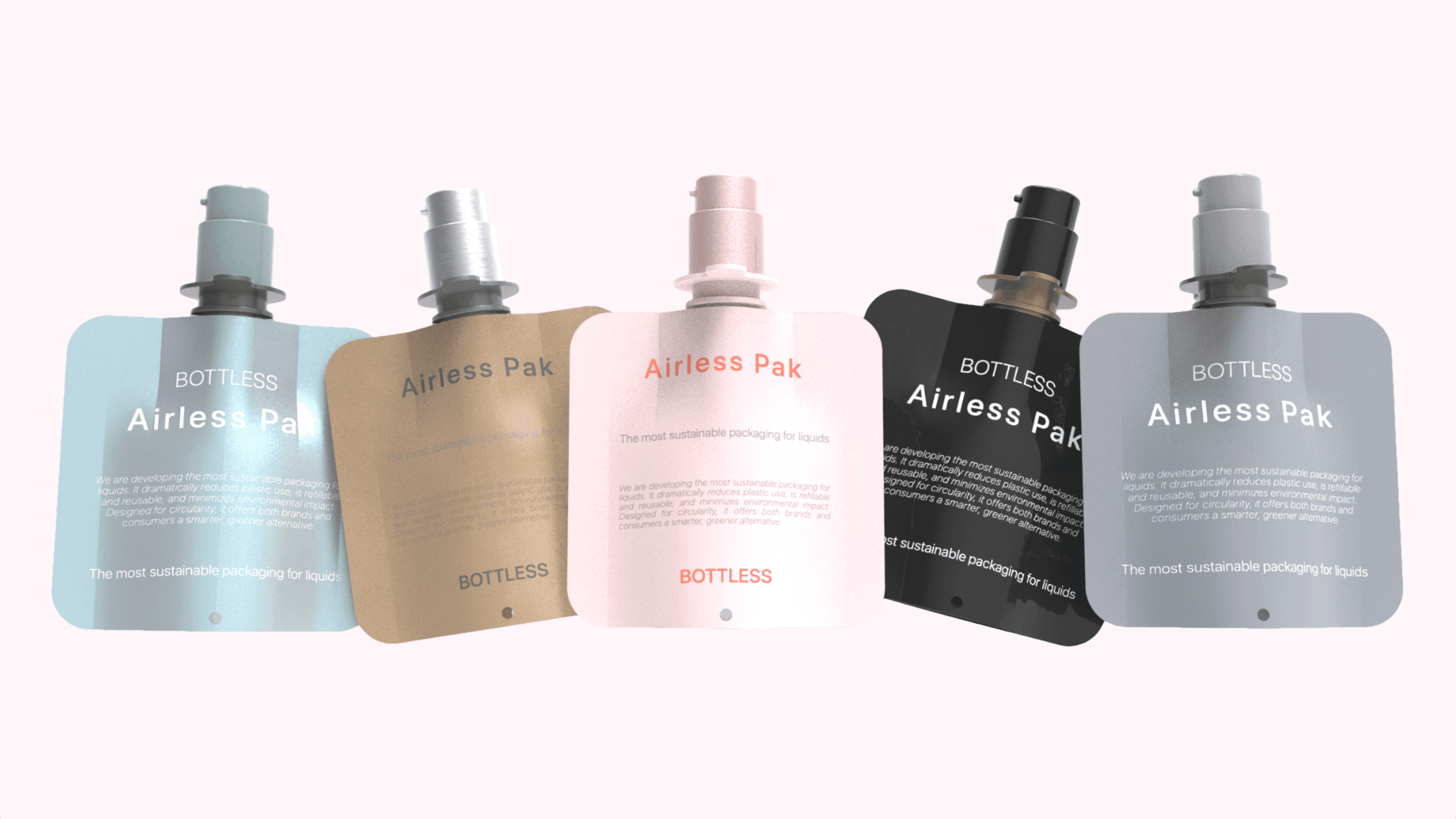Key Points
- Decoupled system: rigid bottle replaced by a flexible high-barrier PE pouch; pump becomes semi-permanent and reusable.
- Mass drop: total plastic falls from ~112 g to ~8.8 g per unit while maintaining airless performance and hygiene.
- Durability: pouch validated for 20+ refill cycles (seal/leak, drop, flex, compatibility, and transport tests).
- Hygiene: one-way airless valve and collapsing pouch block oxygen/contamination from first to last dose.
- Compliance path: mono-material multilayer options to align with PPWR/EPR recyclability and verified sourcing data.
Full interview with BOTTLESS
1. Airless Pak claims to reduce plastic use by up to 90%. Could you specify what material innovations made such a drastic reduction possible without compromising durability or functionality?
Airless Pak achieves up to 90% plastic reduction through a combination of structural redesign and material simplification, rather than relying on alternative resins or composites.
The main innovation lies in decoupling the airless mechanism from the rigid bottle. Conventional airless packaging integrates a heavy, multi-layer container with the pump system to maintain pressure and prevent oxidation. Airless Pak replaces this with a flexible mono-material pouch that collapses as the product is dispensed, allowing the pump to remain semi-permanent and reusable.
This pouch is made from a thin, high-barrier PE film engineered for durability, chemical resistance, and oxygen impermeability, comparable to traditional rigid containers but at less than one-tenth the weight. The pump and refill cap use lightweight PP components optimized for reuse up to 20+ cycles.
By shifting the structural integrity to the pump and using engineered flexibility instead of mass, Airless Pak maintains full airless performance and hygiene protection while cutting the total plastic weight from 112g to 8.8g per unit.

2. The refillable pouch is designed for more than 20 uses. How did you test and validate the material’s ability to withstand repeated refills, handling, and cleaning cycles?
How we tested “refillable & durable”
1/ Repeated-use simulation: We ran the pouch and pump through many dispense–refill cycles to check for fatigue, sticking, and smooth flow.
2/ Seal & leak checks: Heat-seal areas and threaded joints were stressed, squeezed, and bent; we checked for leaks with visual and dye tests.
3/ Flex & drop abuse: Filled pouches were folded, pressed, and dropped to confirm the film and seams don’t crack or delaminate.
4/ Formula compatibility: We stored common cosmetic bases (water, oil, surfactant, alcohol-containing) in the pouch at varied temperatures to watch for swelling, haze, or odor.
5/ Hygiene controls: The system is refilled as a closed transfer (no open cleaning). We handled valves and closures repeatedly and checked that outside handling doesn’t lead to contamination.
6/ Shipping & storage: We ran temperature swings and vibration/drop simulations to mimic transport and shelf life.
Bottom line: The pouch and reusable pump kept function, seal integrity, and hygiene protection throughout testing, giving us confidence in repeated refills under normal use.
3. Hygiene is critical in cosmetics and food packaging. How does your patented airless technology address contamination risks, and what material properties make this possible?
Hygiene and contamination control were central to the development of Airless Pak. Our patented airless valve system completely blocks outside air from entering during use, preventing oxidation, bacterial growth, and contamination, the main causes of product degradation in cosmetics and food packaging.
The system’s fully sealed design allows the internal pouch to collapse as product is dispensed, eliminating any air intake or headspace. Combined with a precision one-way valve and a reusable pump, it maintains a clean and closed environment from first to last use. This ensures product freshness, safety, and hygiene comparable to conventional airless bottles, while enabling a refillable and sustainable format.

4. When designing Airless Pak, what trade-offs did you encounter between lightweighting the material and maintaining barrier performance for product freshness?
Reducing plastic use while maintaining barrier performance was one of the toughest challenges. Airless Pak uses a multilayer film structure, as no single-layer material can currently deliver both mechanical durability and oxygen protection. Each layer is optimized for its role, the outer for toughness, the middle for barrier performance, and the inner for sealability, allowing us to minimize total plastic use while ensuring product stability and safety.
We also developed mono-material multilayer options, which use layers from the same polymer family to improve recyclability while keeping the same airless protection. Depending on the use case, Airless Pak can safely contain up to 500 ml of product while maintaining airless functionality. The large plastic reduction comes not from removing layers, but from replacing rigid bottles with lightweight, refillable pouches, delivering true circular efficiency without compromising performance.

5. As regulatory frameworks in Europe and Asia evolve, how do you anticipate your packaging materials will need to adapt, and how important is access to verified, comparable sourcing data in that process?
Both the EU and Asia are moving toward strict recyclability-by-design and verified traceability mandates. Under the upcoming PPWR, all packaging must be recyclable at scale by 2030, while countries like Korea and Japan are enforcing similar extended producer responsibility (EPR) and recycled-content standards. To stay ahead, BOTTLESS is transitioning our film structures toward mono-material multilayer options that align with industrial recycling streams and verified polymer grades.
Access to verified and comparable sourcing data is becoming essential, not optional. It enables accurate LCA reporting, ensures compliance with region-specific recyclability databases, and strengthens brand credibility under EPR frameworks. That’s why we collaborate closely with certified suppliers to document resin origins, carbon intensity, and recycling compatibility, ensuring that every Airless Pak unit not only meets today’s compliance needs but is already future-ready for the circular packaging economy.








